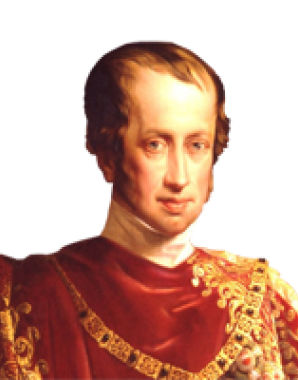Rights and duties in the archducal house
The members of the imperial house had to observe certain rules laid down to guarantee behaviour ‘in keeping with its station’. For example, Habsburgs could not simply marry whom they wanted to.
The ‘Imperial Austrian Family Statute’ of 3 February 1839 was the first document to regulate the legal relations between the members of the imperial house. Until then, as the Family Statute put it, these family relations were based ‘either on pure custom or on a variety of different decrees’. Comprising sixty-one separate clauses, the Statute was issued under Emperor Ferdinand ‘in order that it may serve as an enduring guideline in our most serene imperial house.’
The Statute was divided up into six parts regulating membership of the archducal house, maintenance of non-ruling family members, marriages and wills. As head of the family, the Emperor was responsible for supervising family business and had the authority to make decisions. Members of the family wishing to marry had to obtain the agreement of the head of the family, as laid down in §15: ‘No prince or princess of our imperial house may enter into matrimony without the consent of the head of the family.’ The next paragraph but one issues a warning concerning disregard for this ruling: ‘A marriage contract concluded without this consent is to be regarded as null and void; nor, for the person married and her children, does it result in entitlement to inheritance, appanage, dower and dowry, or to the standing, titles and arms of the members of our house, or to other legal consequences of matrimony.’
However, the Emperor could make exceptions: ‘Morganatic or left-handed marriages may in our imperial house likewise only be validly concluded with the permission of the head of the family.’
On the occasion of the marriage of the heir to the throne Franz Ferdinand in 1900, Emperor Franz Joseph issued an appendix to the Statute listing the families with which Habsburgs might conclude a respectable marriage. Amongst these were fifteen princely houses resident in the Monarchy: Auersperg, Colloredo-Mannsfeld, Esterházy, Kaunitz-Rietberg, Khevenhüller, Lobkowitz, Metternich, Rosenberg, Salm-Reifferscheid-Krautheim, Schwarzenberg, Schönburg-Waldenburg, Schönburg-Hartenstein, Starhemberg, Trauttmansdorff and Windisch-Graetz. Likewise considered as being commensurate with rank and title were marriages with members of thirty-three houses outside the Danube Monarchy, including the Croys, the Fugger-Babenhausens, several lines of the Hohenlohes, Salms and Waldburgs, and the house of Thurn und Taxis.
Although the Statute did not regulate the matter of family members taking their leave of the imperial house, the nineteenth century did see a number of individuals – more or less voluntarily –leave the family, most especially because they were not willing to adhere to the Habsburgs’ strict regulations concerning choice of marital partners.

















